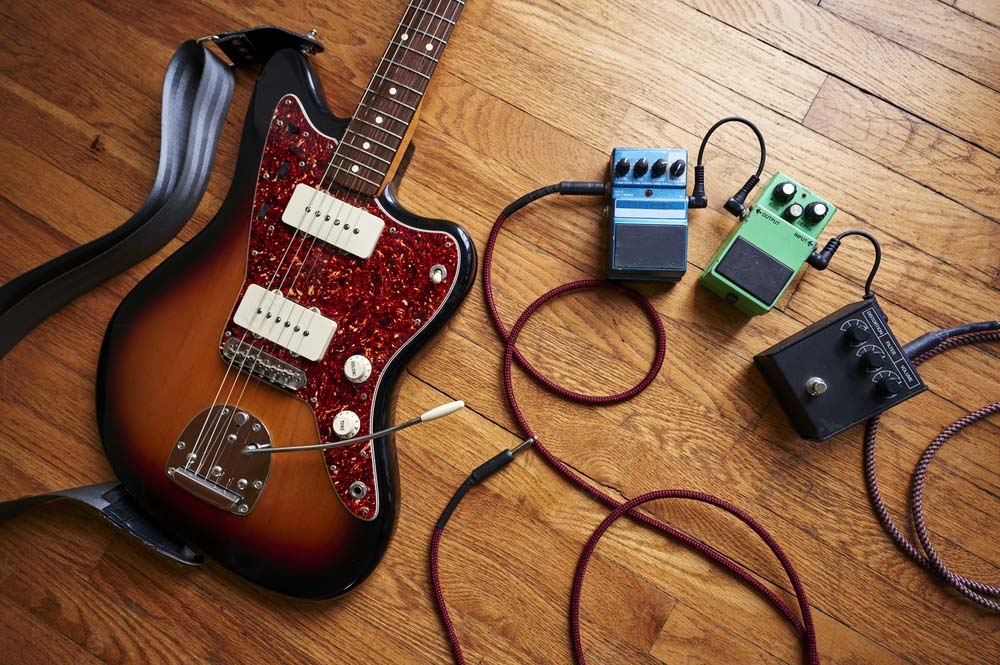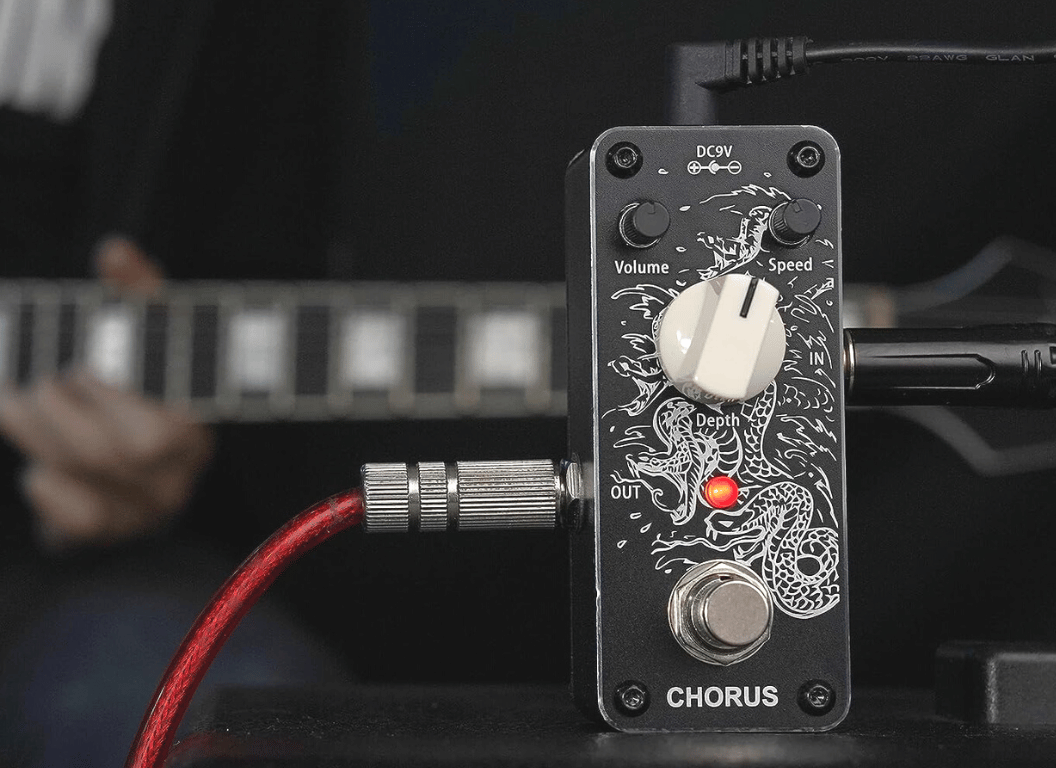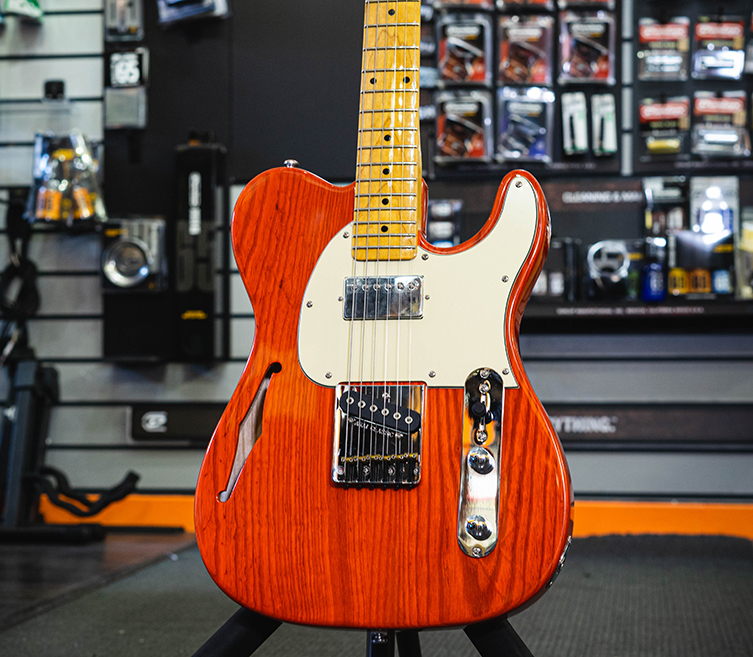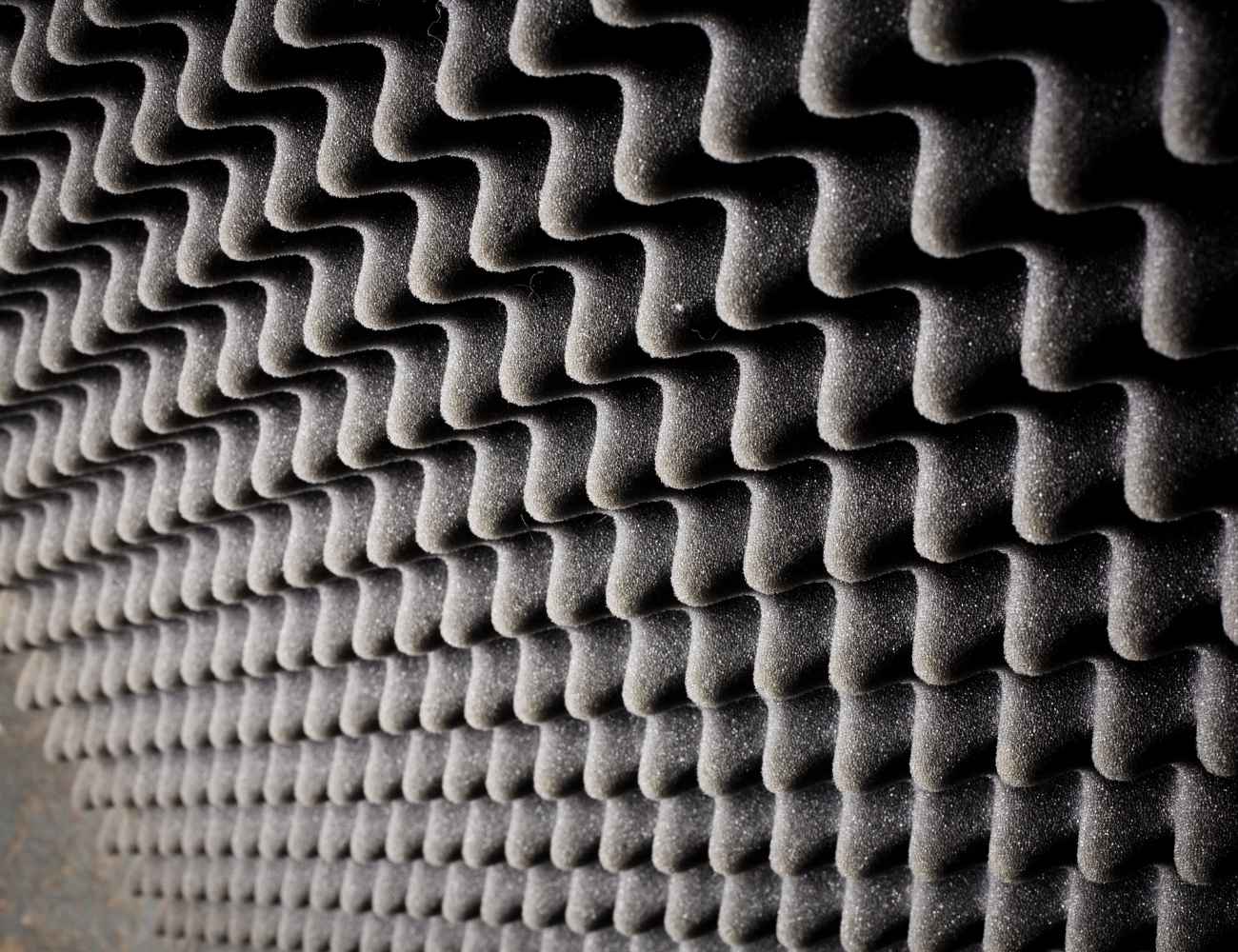Ever tried to crank out that perfect bluesy tone only to end up with something that sounded more like a tin can orchestra?
Choosing the right pedals can be a game-changer.
Our journey today will take us through the world of the best pedals for blues, an essential yet often overlooked aspect of nailing down that authentic blues sound.
We understand that the quest for that sweet, sorrowful tone can be daunting, especially given the myriad of pedals available in the market.
So, we’ve sifted through the noise for you, from overdrive and distortion to reverb and delay, we’ll explore the top-rated blues pedals every guitarist should have.
Table of Contents
- Best Pedals For Blues
- Origin Effects RevivalDRIVE Compact Overdrive Pedal
- Electro-Harmonix Big Muff Pi Guitar Effects Pedal
- Ibanez Tube Screamer Mini Pedal
- Boss RE-2 Space Echo Delay and Reverb Effects Pedal
- MXR Timmy Overdrive Guitar Effects Pedal
- Walrus Audio Emissary Parallel Boost Guitar Effects Pedal
- Boss BD-2 Blues Driver Guitar Effects Pedal
- What are the essential types of pedals for a blues guitarist?
- What should you consider when choosing a blues pedal?
- Multi-effects pedals vs. Individual pedals for playing blues
- How to order pedals on a pedalboard?
- Boutique vs. Mass-Produced pedals
- How much should you spend on a guitar pedal?
- Can you use a guitar pedal with a bass guitar?
- How to properly power your pedals?
Best Pedals For Blues
Before I begin, here are my top selected choices:
Boss BD-2 Blues Driver Guitar Effects Pedal

Authentic blues tone with easy-to-use controls. Check Price
|
|
Electro-Harmonix Big Muff Pi Guitar Effects Pedal

Rich, creamy sustain with adjustable tone and distortion. Check Price
|
Origin Effects RevivalDRIVE Compact Overdrive Pedal
Compact, powerful vintage-style overdrive tone.
RevivalDRIVE Compact is a slimmed-down overdrive pedal with a powerful 3-band EQ, offering clean headroom and a wide range of gain from transparent boost to massive saturation. Its true bypass switch preserves your signal when the pedal is not in use.
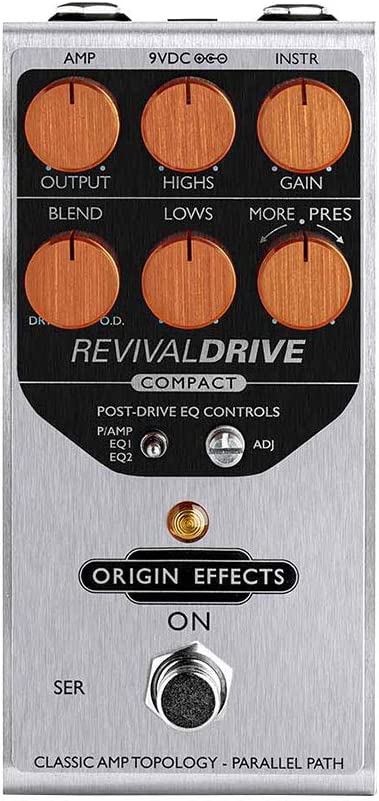
Origin Effects has a gem with the RevivalDRIVE Compact Overdrive Pedal.
Its vintage flair, reminiscent of the glory days of rock, is wrapped up in a conveniently small package.
Designed to mimic the powerful tones of an amplifier, it’s a powerhouse of a preamp pedal that doesn’t take up too much space on your pedalboard.
Equipped with tone blend controls and a post-overdrive equalizer, this unit has a high level of customization at your fingertips.
It’s a nifty gadget that allows you to create and adjust the perfect sound, whatever it may be.
An important aspect to note is its dimensions, coming in at a compact 6.55 x 4 x 3.1 inches and weighing just under 1.5 pounds.
In addition, it operates on a 9-volt power source, making it portable and easily fit into your existing setup.
Although its compact size might be deceiving, don’t underestimate its capabilities.
With the RevivalDRIVE Compact Overdrive Pedal, you can recreate iconic amp sounds and even shape your unique tones.
- My Review
Having spent some quality time with the Origin Effects RevivalDRIVE Compact Overdrive Pedal, it’s clear why this little device is making waves.
Its compact nature defies its powerful performance.
It’s been an absolute pleasure plugging it into my setup and watching it blend effortlessly with my gear while still holding its unique identity.
This device feels like the real deal, sounding so much like an authentic, vintage amplifier that it’s hard to believe it’s not.
Its tone blend controls allow for intricate adjustments, giving you control of the smallest tonal nuances.
The post-overdrive equalizer is another fantastic feature that offers great customization, helping you find the sweet spot in your sound every time.
It’s been an interesting journey to discover how I could make this pedal sing how I wanted it to.
Dialing in that classic JTM45 sound, reminiscent of Cream, Hendrix, and even AC/DC, has been a real treat.
In addition, the potential for blending different aspects of iconic amps using the “more/pres” control, like bridging the gap between Fender Tweed and early Marshall vibes, is a fun exploration.
However, the most surprising feature for me was the blend control.
Adding some of your clean signals to the mix is an absolute game-changer.
It lends a certain naturalness and smoothness to the sound that’s hard to describe but simply phenomenal.
One caveat to consider, though, is that to unlock this pedal’s full potential, one must take the time to read the manual and experiment with the controls.
It may seem daunting initially, but once you get the hang of it, you’re rewarded with many tonal possibilities.
The RevivalDRIVE Compact is not your average pedal.
Here are the ratings I’ll give to the Origin Effects RevivalDRIVE Compact Overdrive Pedal:
Instead, it offers a unique blend of vintage and modern tones, uniquely bringing the past to the present.
Despite its hefty price tag, I’dit’s worth every penny for the tone chaser seeking to recreate those classic overdriven amp sounds.
- Pros:
- Authentic amplifier-like sound and feel
- Versatile with wide range of tones
- Blend control for natural and smooth overdrive
- Ability to combine features of favorite amps
- Great for recreating classic solo sounds
- Cons:
- Relatively high price point
- Requires careful adjustment for optimal settings
My final verdict is that the Origin Effects RevivalDRIVE Compact Overdrive Pedal is an exceptional choice for guitarists seeking an authentic amplifier-like sound and feel.
With its versatile range of tones, blend control for natural overdrive, and the ability to combine features of favorite amps, this pedal offers impressive performance.
In addition, the positive reviews from users highlight its effectiveness in recreating classic solo sounds and its compact design.
Although it may have a relatively higher price point and require careful adjustment for optimal settings, the overall value and brand reputation make it a compelling option for serious musicians.
Electro-Harmonix Big Muff Pi Guitar Effects Pedal
Rich, creamy sustain with adjustable tone and distortion.
The Big Muff Pi Distortion/Sustainer provides a classic rock sound with a rich, creamy, violin-like sustain, perfect for players of all styles. Its volume, tone, and sustain knobs allow you to customize your sound for any situation.
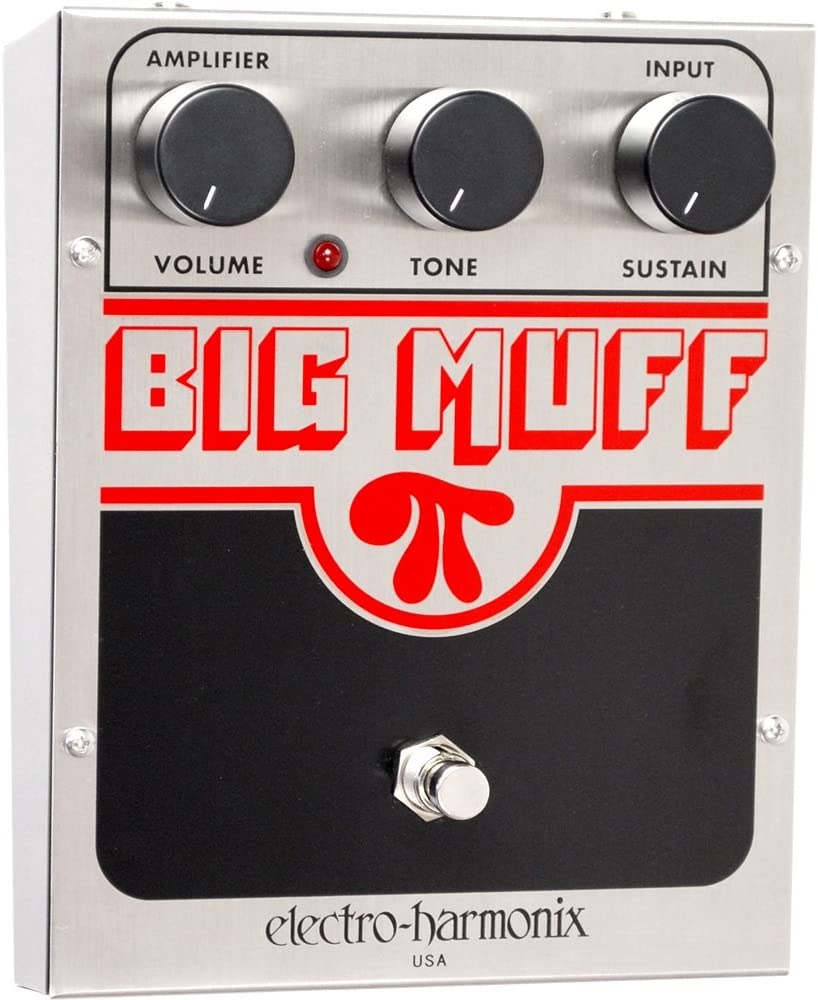
Hailing from New York City, the Electro-Harmonix Big Muff Pi Guitar Effects Pedal is a household name in the world of guitar effects.
Garnering the attention of legendary guitarists like Jimi Hendrix and Carlos Santana in their early days, it has significantly contributed to the guitar sound for over four decades.
Its distinct, rich, creamy, and violin-like sustain has appealed to guitarists of all ages and genres.
This pedal, equipped with volume, tone, and sustain knobs, provides a spectrum of sounds from sharp treble to profound bass.
Its true bypass feature ensures your signal path remains unaffected when the pedal is disengaged.
Running on 9-volt batteries (included with the pedal), it also offers the flexibility to be powered by an optional 9DC-100 power supply.
One of its outstanding attributes is its robust construction, which includes a battery door to simplify battery replacements.
This pedal truly stands out with its unique sustain and distortion qualities.
- My Review
Settling in with the Electro-Harmonix Big Muff Pi Guitar Effects Pedal was an experience.
Its iconic chassis promises a time-tested, robust sound experience, and it didn’t disappoint.
Plugging it in, the pedal powered up without a hitch, a good indicator of its reliable and well-thought-out design.
Exploring the volume, tone, and sustain knobs, I found an array of soundscapes that catered to my every need.
Dialing up the sustain produced an almost symphonic richness that I couldn’t get enough of.
Tuning the tone from sharp treble to deep bass allowed me to color my sound depending on the genre or mood I was aiming for.
The volume knob is responsive, providing an excellent range without unnecessary noise.
The true bypass was a feature that stood out as it provided a pure signal when the pedal was not engaged, a handy feature for preserving the original guitar sound.
Powering up the pedal was seamless with the included 9-volt battery, while the optional power supply added another layer of flexibility for usage.
Despite its great features, the pedal was not without its flaws.
For instance, tweaking the tone settings to find the perfect balance was challenging.
The settings were sensitive and needed a careful touch.
This could be a hurdle for someone new to guitar pedals.
Another notable point was the battery door.
Although it simplifies battery replacement, it felt somewhat loose and raised concerns about its durability.
In terms of its build, it’s a sturdy pedal that appears to be ready for some rough handling, a key factor for the ever-on-the-move gigging musician.
In addition, its iconic design is eye-catching and brings a certain aura to any pedalboard.
Here are the ratings I’ll give to the Electro-Harmonix Big Muff Pi Guitar Effects Pedal:
Navigating the Electro-Harmonix Big M overall, it’s fair to say that it has lived up to its name.
It brought a diverse sound palette to the table, which, coupled with its solid construction, truly sets it apart.
- Pros:
- Adjustable and versatile tone.
- Provides singing sustain and crushing distortion.
- Revered by rock legends and contemporary guitarists.
- Easy to change the 9-volt battery.
- LED Effect-Active indicator light.
- Cons:
- Requires a specific EH proprietary power adapter.
- Larger size, occupying more pedal board space.
- Potential build quality issues in some units.
My final verdict is that the Electro-Harmonix Big Muff Pi Guitar Effects Pedal is a highly recommended choice for guitarists seeking a versatile and powerful distortion/sustainer pedal.
With its adjustable tone, singing sustains, and crushing distortion capabilities, it delivers a rich and creamy sound that blue legends and contemporary guitarists alike have revered.
While there may be some concerns regarding the specific power adapter requirement and the larger pedal, the overall performance, brand reputation, and value make it a worthy investment for musicians seeking that classic Big Muff sound.
Ibanez Tube Screamer Mini Pedal
Iconic Ibanez Tube Screamer Mini for tonal excellence.
The Ibanez Tube Screamer Mini is a classic overdrive pedal with iconic midrange growl and touch sensitivity, perfect for guitarists of all styles. Simple controls and a classic green paint job make it an ideal addition to any pedalboard.
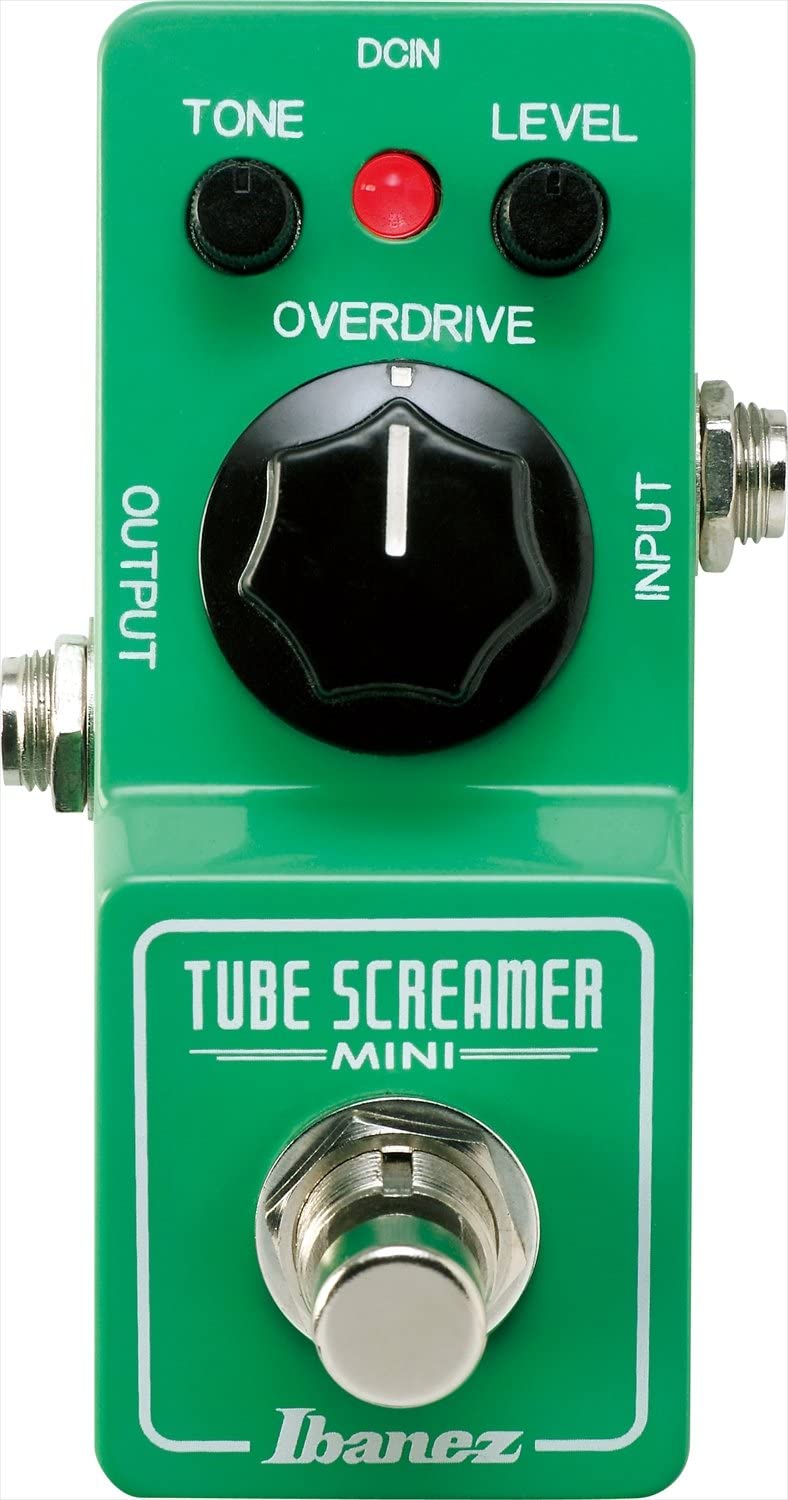
Housing a classic within a small frame, the Ibanez Tube Screamer Mini, an overdrive pedal, comes cloaked in its signature shade of green.
What makes it special is its capacity to deliver a midrange growl so iconic it can effortlessly blend with various guitar styles.
Crafted with simplicity, this diminutive device allows for a broad spectrum of tones by utilizing just three knobs.
Its relatively petite measurements of around 6 x 3 x 4 inches, coupled with a weight of just 240 grams, ensure it won’t waste too much space on your pedalboard.
It’s a distilled version of its full-size counterpart, the TS9, maintaining the same well-loved, bluesy tonal qualities that have made the original a staple for guitarists.
Its compactness adds to its appeal, ensuring a comfortable fit even on crowded boards without compromising on the sound that has made Tube Screamers legendary in the blues genre.
- My Review
Starting with the aesthetics, this overdrive pedal captured my attention immediately with its distinctive green color.
Size-wise, its compact form is impressive – taking up minimal space on the pedalboard, it leaves plenty of room for additional effects.
In addition, the stomp button has a fantastic response without a forceful press to activate it.
Speaking of the effects, this little dynamo does not disappoint.
Its strength lies in its signature midrange growl – a characteristic tone revered in blues music circles.
Adjusting the three knobs modifies the sound, letting me dial in various tones and catering to my varying musical needs.
Despite its size, it holds to its lineage, producing a tonal output reminiscent of the larger Tube Screamer models, particularly the TS9.
One drawback I noticed is the subtle issue with the tone and volume dials.
They’re designed with a minor indentation, making it challenging to see where they are set without closer inspection.
Nevertheless, a little white paint or marker solves this minor inconvenience.
Power-wise, this pedal requires an adapter.
It’s worth noting that it doesn’t come with one, so be prepared to purchase that separately.
Once powered up, the Mini stands ready to enhance your music with its iconic Tube Screamer sound.
Having tested it extensively, I found it added a robust, bluesy, low-gain tone when plugged into a clean amp.
As a result, it became an indispensable tool when I wanted to boost my overdriven amp for solos.
In addition, the natural compression it provides gave my notes an excellent sustain, which was a definite advantage when playing longer passages.
Here are the ratings I’ll give to the Ibanez Tube Screamer Mini Pedal:
Though it had minor flaws, my experience with the Ibanez Tube Screamer Mini left me appreciating its capabilities.
It’s a powerful addition to any pedalboard, particularly for those who enjoy crafting unique blues tones.
- Pros:
- Iconic overdrive sound
- Responsive stomp button
- Good for crowded pedalboards
- Quality tones
- Great for blues and low-gain tones
- Cons:
- Possible switch-pop issue
- Some units may have quality control problems
- Thin sound with reduced bottom end for some users
- Knobs can be hard to read
- May add unwanted distortion and noise
My final verdict is that the Ibanez Tube Screamer Mini is a solid overdrive pedal with iconic tones and compact size.
It offers good versatility, responsive performance, and a durable build.
The brand’s reputation adds to its appeal, and considering its affordable price, it provides good value for guitarists looking to enhance their sound.
However, potential issues like switch-pop, quality control, and thin sound should be considered.
It is a worthwhile addition to a pedalboard, especially for those seeking classic blues and low-gain tones.
Boss RE-2 Space Echo Delay and Reverb Effects Pedal
Authentic Space Echo sounds in a compact, modern pedal.
The BOSS RE-2 Space Echo faithfully recreates the RE-201’s iconic sound and behavior, packed into a compact pedal format. With all-new algorithms, double the delay time, tap tempo, and more, you can experience the legendary magic of the Space Echo with modern convenience.
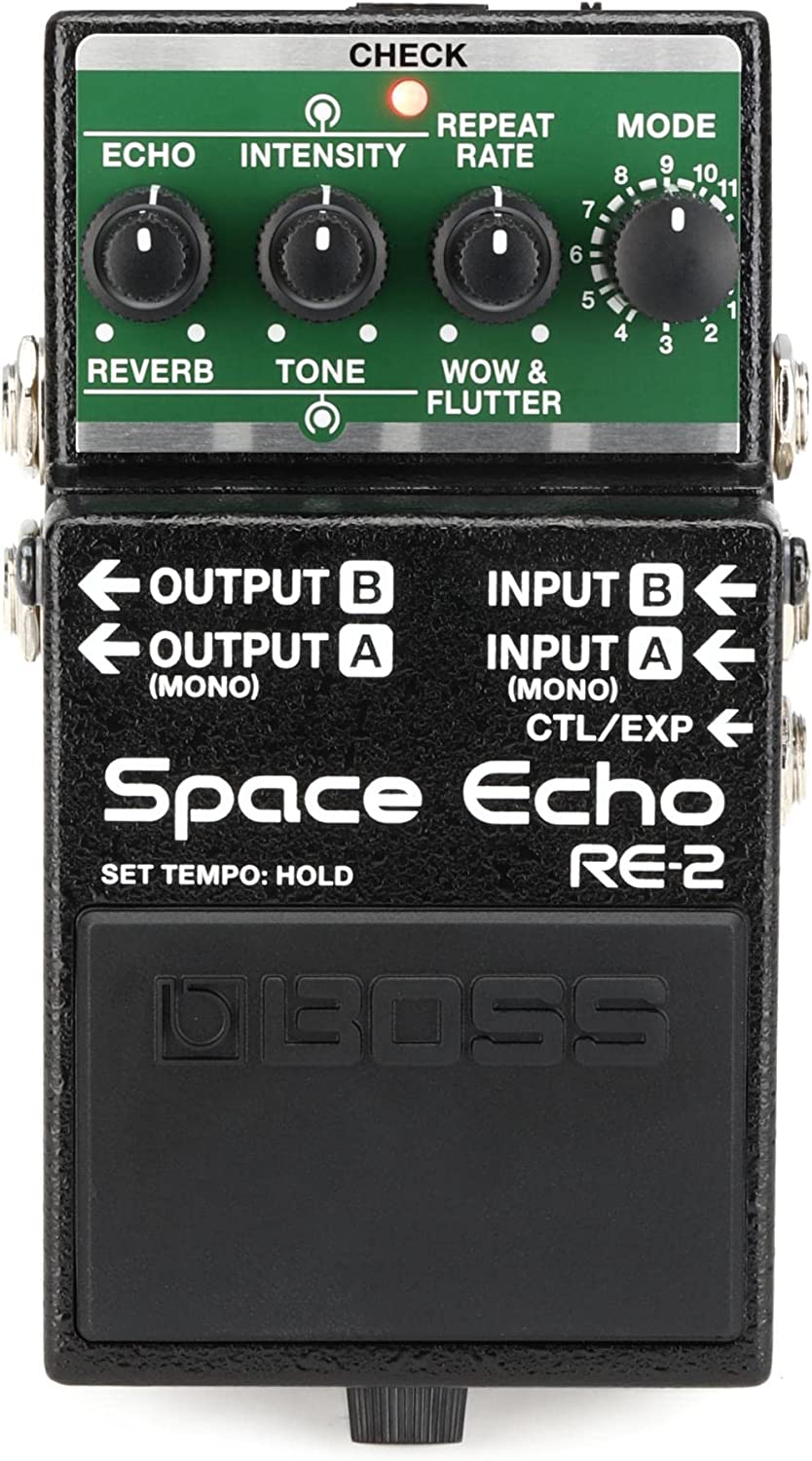
Meet the Boss RE-2 Space Echo, a compact yet feature-packed delay and reverb effects pedal that packs a punch.
This model offers a faithful reproduction of the iconic Roland RE-201 Space Echo, known for its warm, rhythmic echoes and unique quirks, loved by many musicians and producers for over 40 years.
Inside the black casing, which measures approximately 7.87 x 4.57 x 3.35 inches, you’ll find advanced features that mirror the legendary sounds of the original RE-201.
It’s perfect for blues music, with the tape delay spring reverb effects creating a sense of atmosphere and depth.
With the built-in footswitch and expression pedal input, you have complete control over your sound.
A noteworthy feature is the Tap Tempo, which allows precise control over delay timings.
But the magic doesn’t stop there.
This pedal takes it further with its 11-position mode selector, which lets you choose between different virtual tape heads and spring reverb combinations.
As a result, even the pitch change associated with Repeat Rate tweaks and the runaway feedback effect is replicated accurately.
On top of all that, the pedal is built with full stereo I/O and supports external footswitches or an expression pedal for expanded control.
Modern enhancements such as double delay time, a special effects Twist function, and the choice between warm, fat preamp tone or clean signal processing make it a perfect fit for today’s musicians.
- My Review
Stepping on the Boss RE-2 Space Echo for the first time, it quickly becomes clear that this pedal packs a whole universe of sound in a compact, pedalboard-friendly footprint.
Moreover, its black casing feels sturdy underfoot, reassuring me of its reliability on stage or in the studio.
My first impression of the RE-2 is the authentic replication of the vintage Roland RE-201 Space Echo’s sounds, from warm, rhythmic echoes to playful sonic quirks.
Its non-linear behavior is accurately reproduced, with a careful eye for every detail, down to the motor speed fluctuations, friction, and preamp coloration.
The built-in Tap Tempo is an absolute godsend, especially when I’m knee-deep in a blues jam and want to control my delay timings on the fly.
It adds a layer of rhythmic precision, a crucial aspect for a genre like blues that leans heavily on the dynamic interplay of rhythm and lead.
Switching through the 11-position mode selector feels like a journey through the cosmos of sound.
Each setting offers a unique combination of virtual tape heads and spring reverb, letting me dial in just the right atmosphere and depth for my playing.
In addition, there’s something truly mesmerizing about tweaking the Repeat Rate and hearing the gradual pitch change or maxing out the Intensity knob to send my solos into a cascade of runaway feedback.
I admit; I’m quite fond of the pedal’s versatility.
The double delay time and the special effects Twist function feel like modern enhancements that don’t detract from the pedal’s vintage charm.
Plus, choosing between a warm, fat preamp tone or a clean signal opens up many tonal possibilities.
That said, this pedal does present a couple of challenges.
Adjusting the settings live could prove tricky due to the compact pedal.
And if you’re aiming for a precise vintage tape delay sound in the studio, the clean digital sound may not hit the mark.
Here are the ratings I’ll give to the Boss RE-2 Space Echo Delay and Reverb Effects Pedal:
Still, the pedal’s overall performance, authenticity, and versatility are hard to overlook.
Its ability to bring the magic of the Space Echo into a modern context is impressive.
- Pros:
- Versatile delay and reverb effects
- Tap tempo control
- Supports external footswitches and expression pedal
- Full stereo I/O
- Easy to dial in different settings
- Cons:
- Small controls can be challenging in live settings
- Potential battery consumption
- May not fully replicate vintage tape delay sound
- Sound quality may not meet expectations for some
My final verdict is that the Boss RE-2 Space Echo Delay and Reverb Effects Pedal is highly capable and versatile pedal with excellent features.
It delivers an impressive tone and performance, staying true to the revered Space Echo legacy.
The brand’s reputation for quality is evident in this pedal, and while it may not fully replicate the vintage tape delay sound, it still provides a satisfying experience.
Considering its compact size, the pedal offers great value for its price.
However, it’s worth noting that some users may find the small controls challenging in live settings, and there have been occasional reports of battery consumption.
Overall, if you’re seeking a pedal with versatile delay and reverb effects that can enhance your guitar or synth tones, the Boss RE-2 Space Echo is a solid choice.
MXR Timmy Overdrive Guitar Effects Pedal
Professional-grade sweet, harmonic breakup in a mini housing.
The MXR Timmy Overdrive offers a huge range of tones in a small form factor with three clipping options, Bass and Treble cut-only controls, and a LF353 op-amp. It’s perfect for players wanting sweet, harmonic breakup that responds to dynamics while preserving their rig’s character.
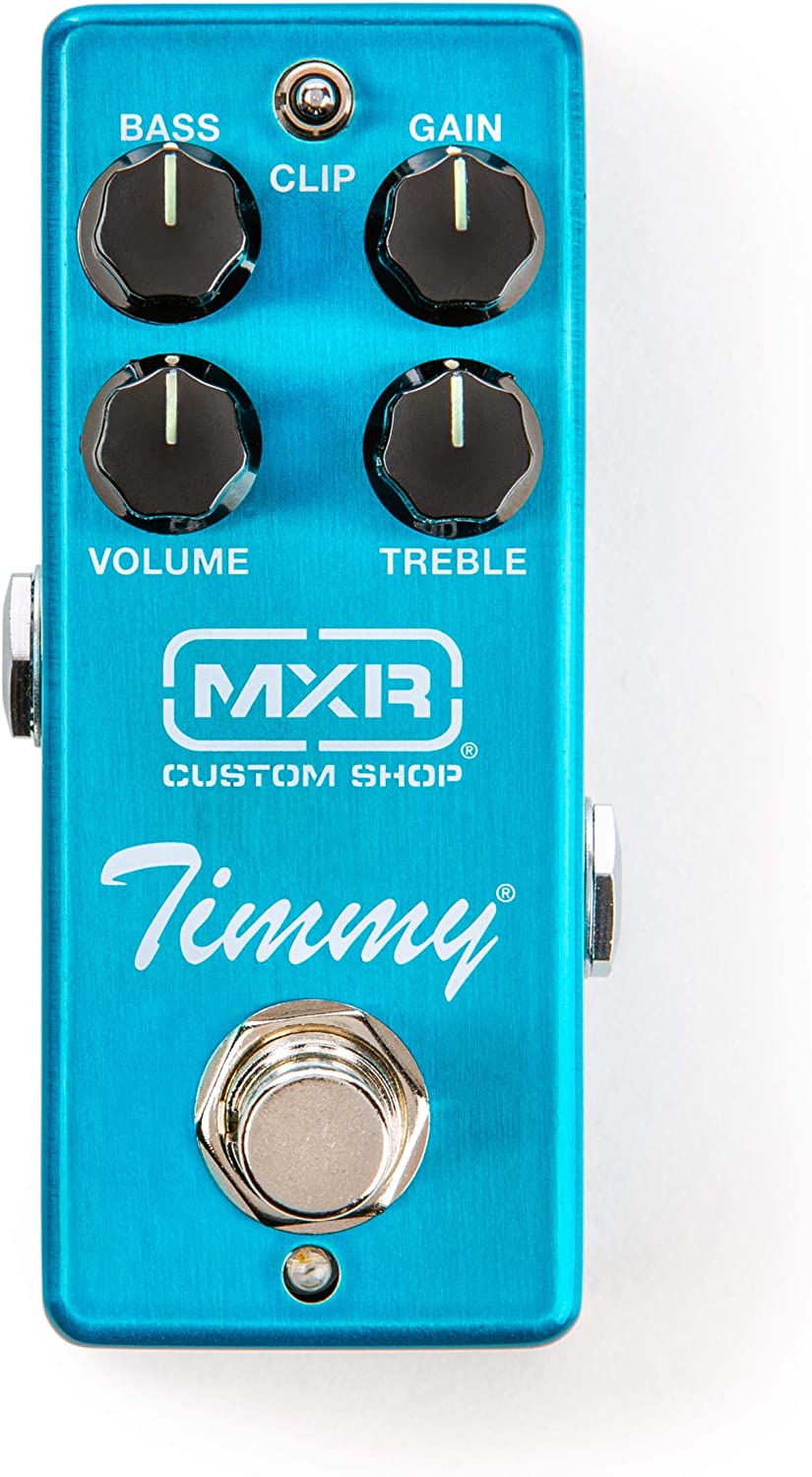
With its roots in Nashville, the MXR Timmy Overdrive Guitar Effects Pedal is a collaboration between the renowned Paul Cochrane and the MXR design team.
This small but mighty tool provides a broad scope of overdrive tones while maintaining the core sound of your guitar setup.
Uniquely suited to blues musicians, Timmy’s three clipping styles cover various playing scenarios, letting you tweak your sound to perfection.
One standout feature is the cleverly designed Bass and Treble controls.
As you explore different gain settings, the Bass control allows you to preserve your low end, while the Treble control adjusts the top end of your post-overdrive signal, keeping your settings smooth and musical.
Moreover, the pedal boasts a sleek and compact design, making it a practical addition to your pedalboard.
As for power, it runs on 9 volts, offering high output, high gain, and excellent signal delivery thanks to its LF353 op-amp.
As a result, it’s the professional’s choice for enhancing your rig’s sonic personality while saving space.
- My Review
Having had the pleasure of putting the MXR Timmy Overdrive Guitar Effects Pedal through its paces, I’m thrilled to share my impressions.
This little powerhouse lives up to its hype, and for a blues enthusiast like myself, it’s a true gem.
Right off the bat, what stood out to me was its true-to-form tonal preservation.
Any blues player knows how important it is to maintain that authentic guitar sound, and with Timmy, your guitar’s natural voice isn’t lost in translation – it’s enhanced.
Likewise, my Stratocaster retained its sparkle and warmth, with the pedal giving a satisfying, bluesy grit when cranked up.
There’s also real magic to the three clipping modes.
Whether I wanted a mild break-up for a subtle, grooving rhythm, or a full-bodied crunch for heart-wrenching solos, Timmy delivered.
Each set offered a distinct character, making it a versatile asset on any pedalboard.
I was equally impressed by the responsive EQ controls.
The Bass and Treble knobs aren’t your standard fare.
However, their intuitive design allows some fine-tuning without sounding harsh or muddy.
Particularly for blues, where the right balance of sparkle and growl can make or break your tone, I found these knobs invaluable.
Its compact design is nothing short of genius.
Despite its size, it doesn’t compromise on power or performance.
And with its LF353 op-amp, you can bet it delivers a high-output, high-gain signal consistently, irrespective of your playing dynamics.
That said, there’s no such thing as a one-size-fits-all pedal.
While the MXR Timmy Overdrive excels in many areas, its vast tonal range might overwhelm beginners.
Here are the ratings I’ll give to the MXR Timmy Overdrive Guitar Effects Pedal:
Nevertheless, its rewards far outweigh the learning curve, particularly for blues lovers seeking to sculpt their signature tone.
In my book, it’s a worthy companion for any serious guitarist.
- Pros:
- Transparent overdrive tones
- Wide range of clipping styles
- Refinable sonic profile with Bass and Treble controls
- Compact size saves pedalboard space
- Cons:
- Potential issues with input/output jacks
- Some users experienced durability problems
- Limited availability of battery power
My final verdict is that the MXR Timmy Overdrive Guitar Effects Pedal is a highly versatile and feature-packed pedal with excellent tone and performance.
The brand’s reputation adds to its appeal, and while it offers great value for its price, there have been some reported issues with the input/output jacks.
It is recommended for guitarists seeking transparent overdrive tones and a compact pedalboard-friendly design.
Walrus Audio Emissary Parallel Boost Guitar Effects Pedal
Powerful, two-in-one boost to bring your tone to life.
Emissary anatomy is a two-in-one boost pedal providing clean, high-headroom JFET boost and mid-frequency boost at either 1kHz or 800Hz. Its bypass switch features momentary function allowing for quick and easy sound manipulation.
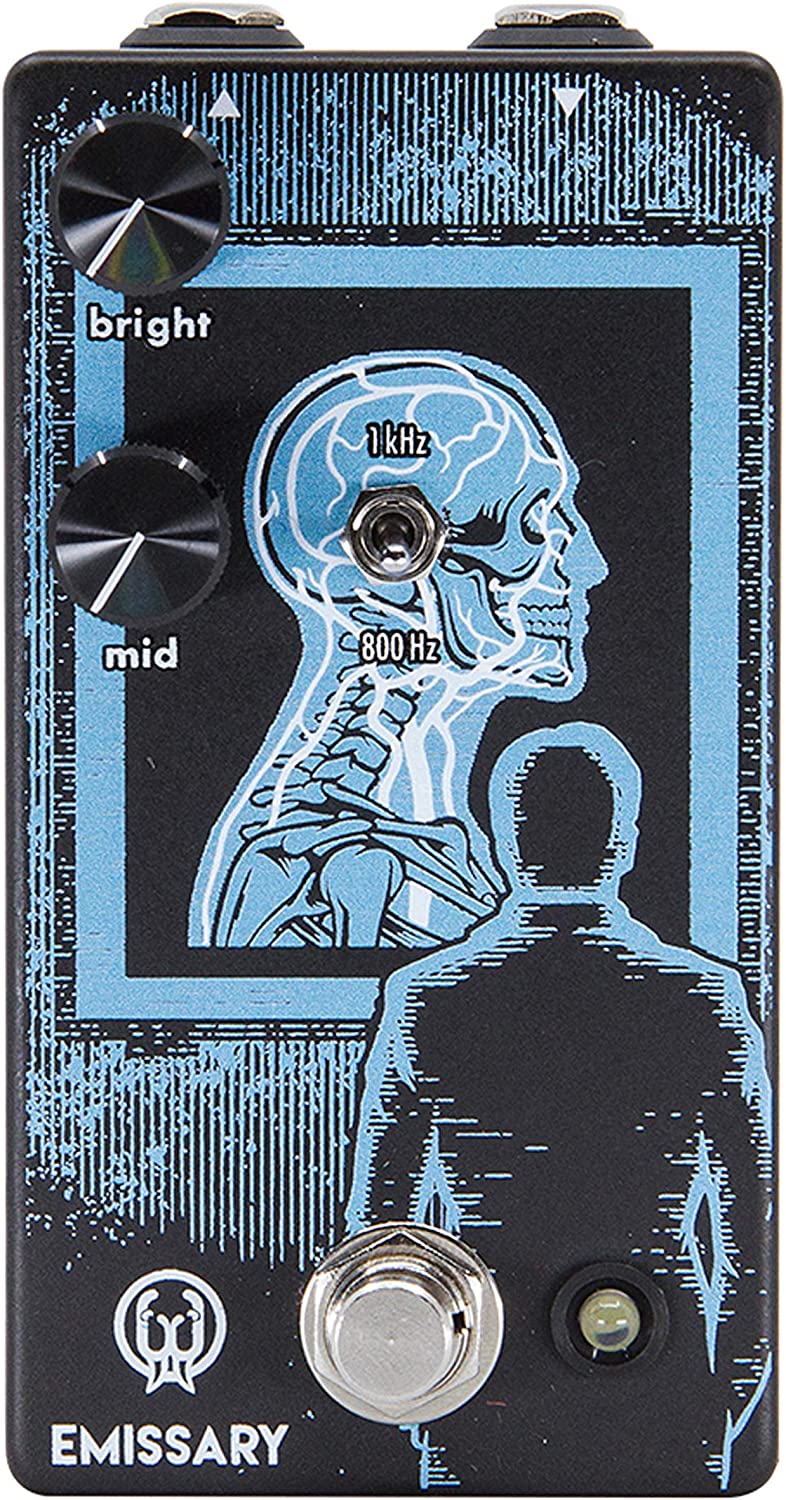
If you’re a guitar enthusiast who enjoys playing the blues, you’ll find the Walrus Audio Emissary Parallel Boost Guitar Effects Pedal a handy companion.
This versatile device boasts two independent boost circuits, “bright” and “mid,” that amplify your tone simultaneously.
Dial up a clear, dynamic boost for your higher notes with the “bright” control, or dial in a concentrated boost at either 1kHz or 800Hz with the “mid” control, based on your preference.
The pedal has been thoughtfully designed to energize your leads, breathe life into fingerpicking and encourage your tube amp to produce an appealing, natural overdrive.
On top of these, it offers a momentary switch feature for spontaneous effect activation, thereby injecting spontaneity into your performances.
Rounding up its key attributes is its captivating silk satin black finish with light blue and white ink. It showcases Adam Forster’s artwork, presenting a stylized X-ray view of a skull, making it a visually appealing addition to your gear.
- My Review
Taking the Walrus Audio Emissary Parallel Boost Guitar Effects Pedal for a spin, I can’t help but be impressed by its multi-layered functionality.
It’s a dual-boost pedal designed to bring out the best in bluesy licks and arpeggios with exceptional clarity and power.
When I plugged it in, I was greeted with a clean, high-headroom JFET boost from the “bright” circuit, adding a shimmering brilliance to the higher frequency notes.
This feature shines especially when you’re playing those slow, soulful blues leads that require each note to ring out with definition and impact.
On the other hand, the “mid” circuit is no less impressive.
It allows for a targeted boost at either 1kHz or 800Hz, a boon for those blues players seeking to dial in that sweet, warm midrange for punchy rhythm patterns or gritty slide playing.
Such flexibility enables the Emissary to adapt to different blues styles with ease.
The momentary function of the bypass switch stood out during my time with the pedal.
It permits a spontaneous activation of the effect for those short bursts of boost, adding an interesting dynamic layer to any performance.
On the downside, there’s a slight learning curve to understand the potential of the dual boost system, but once you get the hang of it, the possibilities are exciting.
Furthermore, while the pedal’s price point might deter some, I believe the unique features and robust build justify it.
Here are the ratings I’ll give to the Walrus Audio Emissary Parallel Boost Guitar Effects Pedal:
Regarding aesthetics, the pedal scores high with its silk satin black finish and intriguing artwork by Adam Forster.
In my hands, it performed exceptionally and added a dash of style to my pedalboard.
- Pros:
- Great for driving amp speakers.
- Versatile 2-in-1 boost pedal.
- Enhances leads, slides, fingerpicking.
- Cons:
- Not essential if you don’t need a boost pedal.
- Price may be considered high for some.
- Components may not meet expectations.
My final verdict is that the Walrus Audio Emissary Parallel Boost Guitar Effects Pedal offers a versatile and feature-rich option for enhancing your guitar tone.
Its dual boost circuits provide flexibility for different playing styles and preferences.
The positive reviews highlight its effectiveness in driving amp speakers and making leads stand out.
However, it’s important to consider that it may not be essential for your setup if you don’t specifically need a boost pedal.
Additionally, the price could be a factor to consider, and there are some critical remarks regarding the components.
But, overall, if you’re seeking a boost pedal with various tonal options and are willing to invest in its features, the Walrus Audio Emissary Parallel Boost could be a worthwhile choice.
Boss BD-2 Blues Driver Guitar Effects Pedal
Authentic blues tone with easy-to-use controls.
The BD-2 Blues Driver pedal provides warm overdrive and distortion tones perfect for blues, creating the sound of classic tube amps in an instant. Its easy-to-use knobs make it easy to dial in the perfect tone.
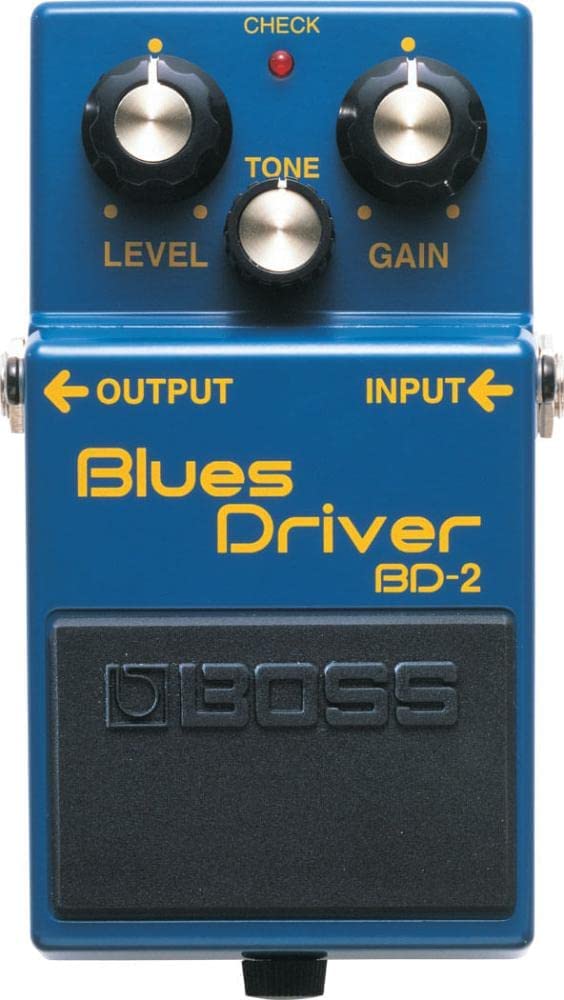
A mainstay in the world of guitar effects, the Boss BD-2 Blues Driver is an intriguing device that delivers an expressive, distinctive tone.
Its purpose-built design allows guitarists to bring out that much sought-after blues sound with creamy crunch and dynamic distortion.
This compact powerhouse takes inspiration from vintage tube amplifiers, often responsible for some of the best blues tones we know.
The physical characteristics of the pedal are just as impressive, with dimensions measuring 5.95 x 3.75 x 2.75 inches and a weight of just 300 grams.
Not only does this pedal offer Level and Gain controls, but it also provides a Tone knob for the ultimate control over your sound.
Boasting the iconic Boss design in a striking blue color, this pedal sounds good and looks the part.
It’s a pedal that breathes new life into your guitar setup, infusing your sound with the warmth typically associated with classic, aged tube amps.
- My Review
In seeking the perfect blues tone, I discovered the Boss BD-2 Blues Driver Guitar Effects Pedal, a device that seemed to promise the embodiment of the bluesy, warm overdrive we all yearn for.
Upon first look, its compact size and weight and the quintessential Boss blue hue offered a promise of robust quality without overwhelming bulk.
Engaging with the pedal felt immediately rewarding.
Its controls, featuring Level, Gain, and the crucial Tone knob, provided ample room for dialing in the exact sound I was pursuing.
With some manipulation, I noticed the BD-2 capably replicates the emotive distortion often linked with venerable tube amps, bestowing my guitar with a beautifully gritty yet controlled voice.
Yet, it’s not all about that crunch – it captures the softer, creamier side of blues wonderfully, providing a versatile palette for expressing musical emotion.
However, it wasn’t all sunshine and roses.
The pedal seemed to falter in my quest for lighter overdrive tones at lower gain settings.
Rather than offering the nuanced coloring I expected, it produced a clipping sound that lacked the desired smoothness.
But this minor hiccup was redeemed by the pedal’s impressive performance when used as a simple boost or dialed into a higher gain setting.
Additionally, I came across some variations in the product versions available in the market, with differing potential for upgradeability.
This might be something to remember for those who value future modifications.
Here are the ratings I’ll give to the Boss BD-2 Blues Driver Guitar Effects Pedal:
Despite these small setbacks, the Boss BD-2 Blues Driver secured a place in my gear with its unique sound, quality build, and fidelity to the blues ethos.
While it may not be ideal for every situation, it shines brilliantly where it matters – in delivering a great blues tone.
- Pros:
- Warm overdrive and emotive distortion
- Suitable for blues and old school music
- High-quality build and great tone
- Versatile sound from crunch to rock punch
- Works well with Fender Stratocaster
- Cons:
- Does not provide expected blues feeling for some
- May not deliver desired coloration at low gain
- Non-upgradable version available
- Sound may not meet expectations for some users
- Similar functions to other pedals on the market
My final verdict is that the Boss BD-2 Blues Driver Guitar Effects Pedal is a versatile and feature-rich pedal that delivers warm overdrive and emotive distortion, making it suitable for blues and old-school music.
The pedal has received positive reviews for its high-quality build, great tone, and compatibility with Fender Stratocaster guitars.
However, it’s worth noting that some users have reported issues with achieving the desired blues tone and have found similar functions in other pedals.
Nevertheless, considering its brand reputation, the Boss BD-2 Blues Driver Pedal offers good value for guitarists seeking a versatile overdrive option.
What are the essential types of pedals for a blues guitarist?
Throughout the history of blues guitar, artists from Robert Johnson to Stevie Ray Vaughan have developed their unique voices by masterfully combining dynamics, technique, and gear.
While a massive part of the authentic blues sound comes from within the player’s soul and fingers, the right stompbox can push that sound to a new level.
For a blues guitarist, a variety of essential pedals can contribute to creating that quintessential tone that holds power to captivate listeners.
These pedals encompass multiple effects, including overdrive, compression, reverb, delay, tremolo, and wah.
Combined, they help forge the foundations of blues guitar playing, allowing guitarists to express their musical ideas and emotions genuinely.
– Overdrive
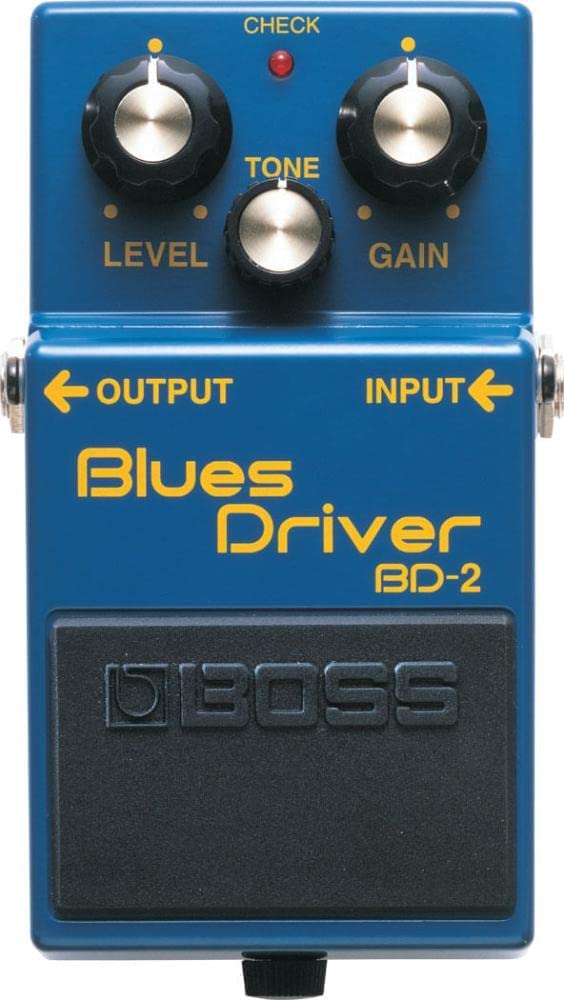
Overdrive pedals are at the heart of blues guitar tones, generating the natural breakup and warm tube tones we’ve come to love.
Overdrive gently clips your guitar’s signal, just like how vintage tube amplifiers start to break up and saturate when cranked up.
This effect is ideal for providing that extra bite needed to cut through a mix, enhancing dynamics, and giving solos the perfect edge.
– Compression

A compression pedal is next on a blues guitarist’s list of essential pedals.
The compression evens out the dynamic range by reducing loud frequencies and boosting quieter ones.
What this does is that it provides greater sustain and a more consistent volume level for fingerpicking and slide work.
Although compression is often subtle, it can significantly impact the overall clarity and balance of a blues guitar player’s tone.
– Reverb
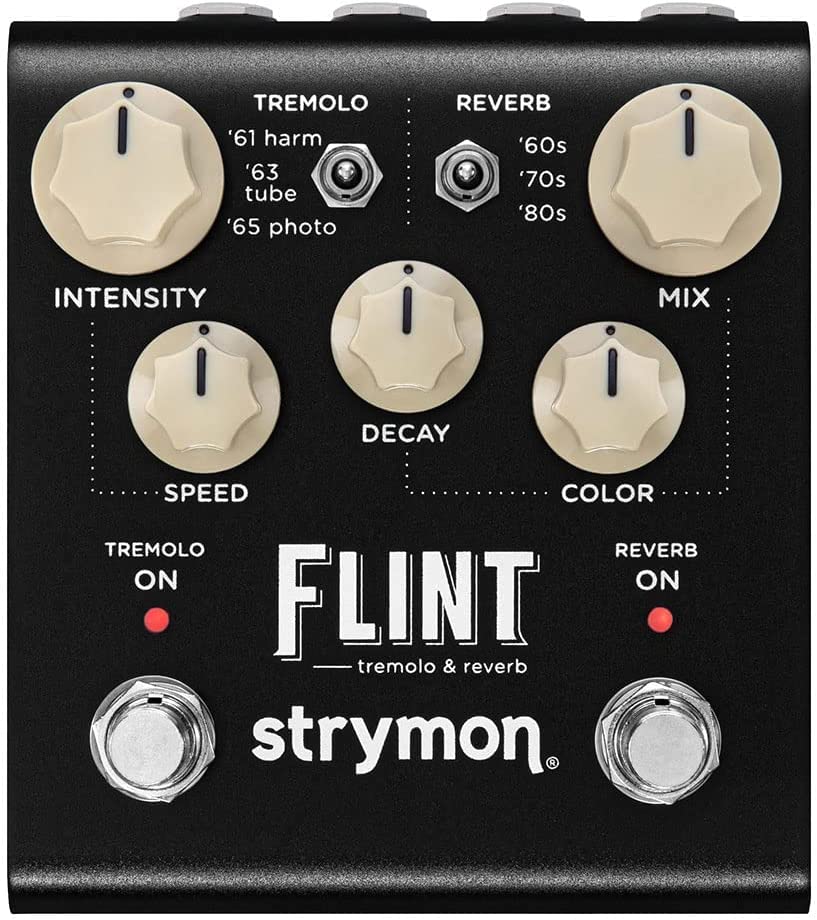
Reverb pedals are another essential item in the toolkit of a blues guitarist, adding depth, space, and ambiance to their sound.
Reverb emulates a physical space’s natural reflections and echoes, thus turning a dry, flat tone into a rich, three-dimensional sound.
As a result, blues players often gravitate towards spring reverb sounds, which emulate vintage amp reverb tanks and provide a lively effect.
– Delay

Every blues guitarist needs a delay pedal to breathe life into their solos and add depth and space to their sound.
Delay pedals repeat your guitar signal and several repeats (feedback) at a specified time, creating anything from a subtle slap-back echo to vast, sprawling soundscapes.
– Tremolo

Tremolo is an effect familiar to fans of vintage blues and roots rock, where the guitar signal’s volume is constantly modulated to create a wobbly, pulsating sound.
Famous examples include “Born on the Bayou” by Creedence Clearwater Revival or the classic instrumental track “Rumble” by Link Wray.
– Wah-wah
The Wah pedal is a timeless addition to a blues guitarist’s setup.

Wah uses a foot-operated rocker pedal to sweep through frequencies, effectively altering the tone and expressiveness of the guitar signal.
Moreover, this effect can be manipulated in real-time, allowing players to create captivating, expressive, emotional, and vocal-like sounds with the blues-rock genre from Jimi Hendrix’s “Voodoo Child (Slight Return)” to Stevie Ray Vaughan’s blistering wah solos.
What should you consider when choosing a blues pedal?
When choosing a blues pedal, several factors come into play to ensure you find the perfect stompbox to suit your playing style, personal preference, and overall sound you want to achieve.
Here are some essential aspects to consider when choosing a blues pedal for your setup:
– Tonal qualities
Blues, as a genre, is quite diverse and encompasses various styles, ranging from the subtle fingerpicking of acoustic Delta blues to the all-out distortion of Texas blues-rock.
Identifying the specific tonal qualities you’re looking to create through your pedals is essential.
Then, please spend some time researching and listening to the specific blues styles and guitarists that inspire you, paying close attention to their use of overdrive, compression, modulation, and other effects contributing to their overall sound.
– Overdrive vs. Distortion vs. Fuzz
Many blues players rely heavily on their overdrive, distortion, or fuzz pedals to achieve that distinctive, grittier sound.
It’s essential to know the difference between these three types of pedals to make an informed decision.
Overdrive pedals provide a warm, tube-like breakup for mild crunch and gritty leads.
Distortion pedals deliver a more aggressive gain structure, pushing the boundaries of blues into rock and hard rock territory.
Fuzz pedals offer a unique, almost broken-sounding character, loved by guitarists like Jimi Hendrix and Eric Clapton during his Cream days.
When choosing a pedal for blues, consider the varieties of gain you want in your arsenal.
Many versatile guitarists opt for a combination of stacking overdrive and distortion pedals in different sections of their signal chain.
– Quality and budget
As with any gear purchase, you must balance quality and budget.
High-quality, boutique pedals are available that deliver superior sound and build quality but can be expensive.
On the other hand, many affordable options still offer excellent sound and functionality.
It’s crucial to weigh these factors and decide to balance sonic quality with your budgetary constraints.
– Pedal size and signal chain
When choosing a blues pedal, consider its size and how well it fits into your signal chain.
Many modern pedal companies now offer so-called “mini” pedals, providing similar tones to their larger counterparts but in a more compact form factor.
It’s important to ensure that any pedal you choose can integrate seamlessly into your existing pedalboard setup, considering its size, power requirements, and input/output compatibility.
– Bypass type of the pedal
Pedals come in two main varieties when it comes to bypass: true bypass or buffered bypass.
True bypass pedals will not impact your overall signal chain when the effect is switched off, maintaining your guitar signal’s integrity.
On the other hand, Buffered bypass pedals can help preserve your signal when running long cable lengths or using a large number of pedals.
It is essential to consider which bypass type suits your setup better when choosing a blues pedal.
Many guitarists balance true bypass and buffered bypass pedals to benefit from both options.
– Compatibility with guitar and amplifiers
Every pedal will react differently to the specific type of guitar and amplifier it uses.
When choosing a blues pedal, consider how well it complements the gear you already own to achieve the desired tone effectively.
Some pedals work better with certain types of guitars (single coils or humbuckers) and amplifiers (tube or solid-state).
It’s helpful to watch demo videos and read product reviews that mention the type of equipment they’ve tried the pedal with, giving you a better idea of how it might perform with your setup.
– Versatility and adjustment options
Balancing dedicated, single-function pedals and versatile, multi-function pedals is essential when building a pedalboard.
Understandably, having a pedal for every possible sonic need is impractical, making it critical to select flexible pedals in terms of their adjustment options and versatility.
While more specialized pedals can shine in their particular areas, choosing a blues pedal that offers control over various parameters allows you to fine-tune the effect to your liking.
This flexibility can be advantageous in adapting to various playing situations and sound requirements.
– Brand reputation and reliability
The market is flooded with various brands and models of guitar pedals, making it crucial to research the reputation and reliability of the particular pedal you’re interested in and the company that produces it.
Look for well-respected brands that offer solid customer support and good build quality, ensuring that your pedal will sound great and stand the test of time.
– Pedal simplicity and ease of use
Depending on your preferences, look for a pedal that offers the desired level of ease in operation.
For example, some pedals come with straightforward and basic controls, while others are loaded with knobs and switches for more macro control.
Additionally, factor in how quickly and easily you need to adjust during live performances, as this can significantly impact your decision.
Multi-effects pedals vs. Individual pedals for playing blues
The debate between multi-effects units and individual stompboxes has been ongoing for many years.
Ultimately, choosing to use a multi-effects pedal or stick to individual pedals for playing blues boils down to personal preference, playing style, and the specific tonal goals you want to achieve.
Both options have pros and cons; understanding these will help you make a more informed decision tailored to your needs.
Multi-effects pedals have come a long way in recent years, with technological advancements improving sound quality, versatility, and ease of use.
These units can offer various effects, from overdrive and distortion to modulation, time-based effects, and much more, all housed within a single device.
Many multi-effects units also incorporate expression pedals, allowing real-time control over effects parameters such as wah, volume, or delay levels.
– Pros of multi-effects pedals:
Versatility: Multi-effects units provide access to numerous effects in a single device, making them an all-in-one solution for guitarists seeking a vast array of sounds.
This can especially benefit blues players inspired by various subgenres and styles, allowing seamless transitions between tones.
Cost-effectiveness: Unlike purchasing numerous individual pedals, investing in a multi-effects unit can be more affordable.
This is particularly true for beginner guitarists or those on a tight budget looking to explore various effects without investing in separate stompboxes.
Space-saving and convenience: Multi-effects units are generally more compact and portable than carrying around a large pedalboard with individual pedals.
This makes them ideal for musicians who often travel, play in different locations, or prefer a more minimalist setup.
Preset options and ease of use: Many multi-effects pedals allow users to create and store presets, enabling seamless transitions between various effect combinations.
Additionally, these units can sometimes be simpler, requiring only one power source and fewer cables to manage.
– Cons of multi-effects pedals:
Limited customization: While some multi-effects units offer deep parameter-editing capabilities, they often cannot provide the level of customization and unique tonal characteristics that individual pedals can.
This can challenge those seeking specific tones or combinations unavailable within their multi-effects pedal.
Potential compromise in sound quality: Although modern multi-effects units have greatly improved sound quality, some guitarists argue that individual pedals can deliver a superior tone.
For some blues players, individual stompboxes’ analog warmth and unique tonal character may appeal more than the digitally produced sounds in multi-effects units.
Less tactile control: Many guitarists appreciate individual pedals’ simplicity and immediate response with dedicated physical controls (knobs and switches).
In comparison, multi-effects pedals might require menu navigation and screen adjustments to tweak particular settings, which can be less intuitive and time-consuming during live performances.
As for individual pedals, guitarists have long favored these stompboxes for their unique tonal qualities, ease of use, and the ability to “mix and match” according to personal preferences.
For example, blues guitarists often gravitate towards individual pedals due to the appeal of warm, analog tones and the satisfaction of customizing their signal chain to match their playing style and desired sound.
– Pros of individual pedals:
Customization and personalization: Individual pedals allow guitarists to curate their effects collection, tailoring their signal chain to their unique needs and sound preferences.
This allows for a more personal approach to creating a signature tone.
Distinctive tonal characteristics: Individual pedals are often designed to produce specific, unique sounds that propel them to legendary status.
For blues players, emulating the tone of their favorite guitarists or discovering new sounds may only be achievable through individual stompboxes.
Tactile control and ease of use: Individual pedals offer physical knobs and switch for instant control over effect parameters, making them more intuitive to use on the fly, especially during live performances.
– Cons of individual pedals:
Higher cost and space requirements: Building a pedalboard with individual pedals can be more expensive and space-consuming than investing in a single multi-effects unit.
Increased complexity: Individual pedals require power supplies, patch cables, and the organization of a pedalboard, which can be overwhelming for beginners or players seeking a simpler setup.
To finish, multi-effects pedals and individual stompboxes have their own merits, and the best option for playing blues depends on personal preference, playing style, and desired tone.
Multi-effects units offer versatility, cost-effectiveness, and portability, while individual pedals provide customization, unique tonal qualities, and tactile control.
Consider your specific needs and priorities when deciding whether to use a multi-effects pedal or individual pedals for playing blues; experimentation and self-discovery will guide you in finding the perfect combination of effects to help you develop and express your musical vision.
How to order pedals on a pedalboard?
There is no one-size-fits-all approach to ordering pedals on a pedalboard, as the optimal arrangement largely depends on the specific sound you’re aiming for.
Usually, though, you will see guitar players mostly agreeing with this order:
Tuner > Filters/Dynamics > Pitch-based Effects > Overdrive/Distortion > Modulation > Time-based Effects > Looper
Aside from that, some general guidelines can help you achieve a balanced and versatile setup.
Let’s talk in detail about the order we just mentioned, but feel free to experiment and adjust to your own preferences:
- Tuner: Place your tuner pedal first to ensure your signal is in tune before passing through the other pedals.
- Filters and dynamics: Wah-wah, envelope filters, compressors, EQs, and noise gates should come next. These pedals affect your sound’s dynamic and tonal aspects, so it’s best to place them early in the chain.
- Pitch-based effects: Octavers, harmonizers, and pitch shifters should come after filters and dynamics since these pedals alter the pitch of your signal and work best with a clean, unprocessed sound.
- Overdrive and distortion: Overdrive, distortion, and fuzz pedals typically come next. They shape your guitar’s core sound, and placing them before most other effects ensures that those effects receive a strong, consistent signal.
- Modulation effects: Chorus, flanger, phaser, and tremolo pedals should be placed after overdrive and distortion effects. We do this to allow these pedals to add depth and movement to your sound without becoming overly distorted or overbearing.
- Time-based effects: Delay and reverb pedals should be placed towards the end of your signal chain. This allows them to create a sense of space and depth around the other effects, simulating the sound of a room or hall.
- Looper: If you use a looper pedal, it should be placed last in the chain. This ensures that you’re looping the entire signal, including all the effects you’ve applied.
Remember, these are just general guidelines and what generally works and sounds good.
The most important thing is to experiment and find the arrangement that best suits your personal sound and style.
For example, here’s one pedalboard signal chain that I always use:
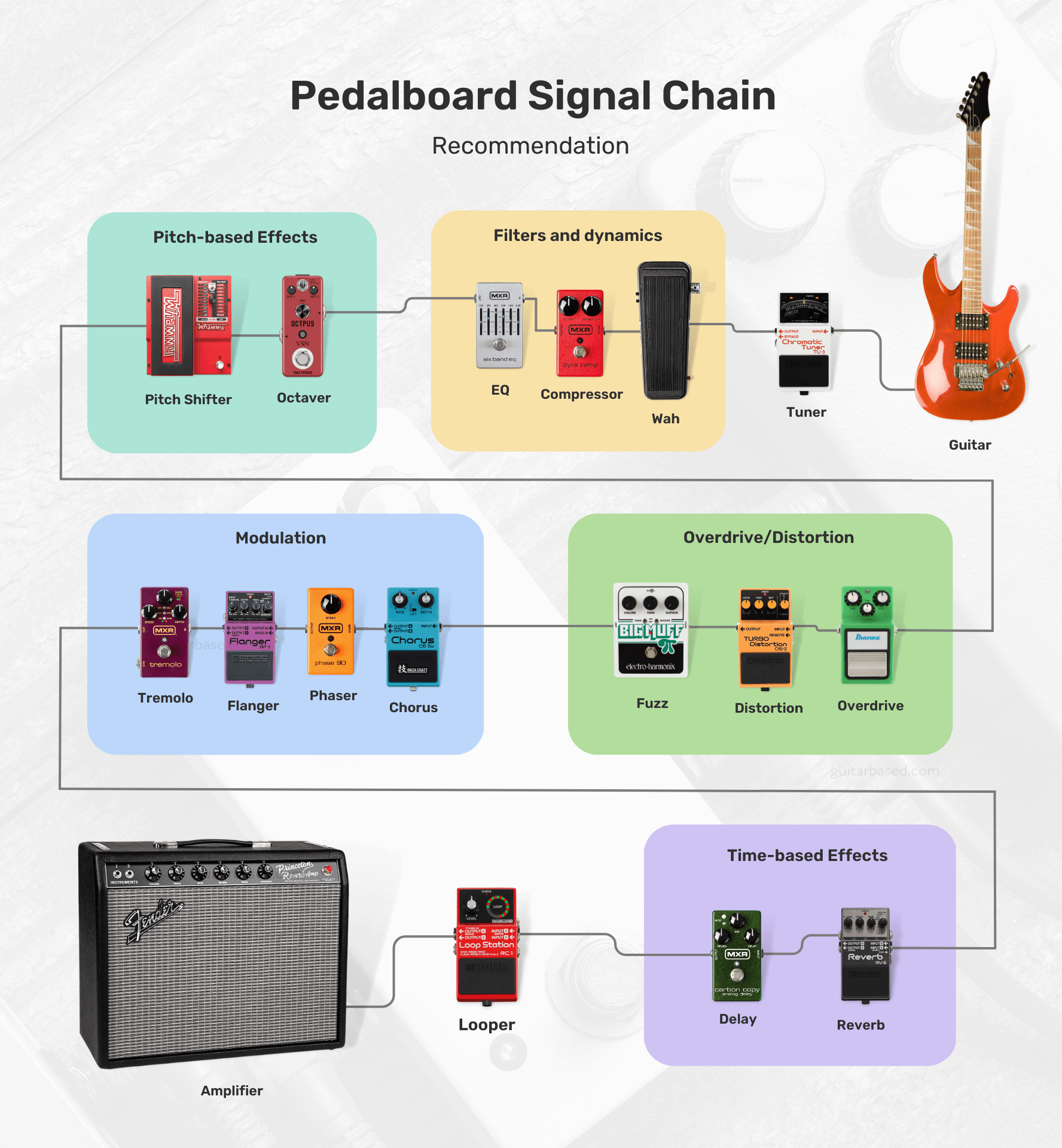
Feel free to swap the order of pedals, try different combinations, and test out unconventional setups until you find the one that works best for you.
For those interested, I’ll leave you with most of the possibilities that you’ll encounter and how to order them.
- Tuner
- Filters/Dynamics:
- Volume
- Wah
- Auto-Wah
- Compressor
- Noise Gate
- EQ (Equalizer)
- Pitch-based Effects:
- Octaver
- Harmonizer
- Pitch Shifter
- Overdrive/Distortion/Fuzz:
- Boost
- Overdrive
- Distortion
- Fuzz
- Modulation:
- Chorus
- Phaser
- Flanger
- Univibe
- Vibrato
- Tremolo
- Time-based Effects:
- Delay
- Echo
- Reverb
- Synth/Bitcrusher:
- Synth
- Bitcrusher
- Acoustic Simulator
- Multi-Effects
- Utility:
- Buffer
- A/B/Y Switcher
- MIDI Controllers
- Looper
Boutique vs. Mass-Produced pedals
Boutique pedals are generally built with higher-quality components and craftsmanship, resulting in better durability and longevity.
These pedals often feature unique and innovative designs, providing a wider range of tones and effects that may not be available in mass-produced options.
Here are a few examples of boutique pedals:

All the manufacturers also tend to have a more personal approach, with better customer service and the ability to customize pedals according to the user’s preferences.
However, boutique pedals are usually more expensive due to the smaller scale of production and the use of premium components.
Mass-produced pedals, on the other hand, are more affordable due to their larger scale of production and the use of cost-effective components.
These pedals are widely available and offer a range of popular effects, making them accessible to a larger audience.
Here are a few examples of mass-produced pedals:

The quality control for mass-produced pedals can vary depending on the brand and model, but many are reliable and offer good value for the money.
As for one of the downsides, you’ll find that mass-produced pedals may not have the same level of uniqueness or innovation as boutique options.
On the other hand, they may not provide the same level of customer service or customization options.
The choice between boutique and mass-produced pedals depends on your personal preferences, budget, and desired sound.
If you’re looking for unique tones, higher-quality components, and a more personal experience, boutique pedals may be the way to go.
But I would say, for those who are on a budget and need access to popular effects, mass-produced pedals might be a better fit.
It’s worth trying out both types to see which best suits your needs and playing style.
How much should you spend on a guitar pedal?
If I were in your position, I would first determine my budget and specific needs before deciding how much to spend on a guitar pedal.
For beginners, it might be more reasonable to start with affordable, mass-produced pedals to explore different effects without spending too much.
Guitar pedals can range in price from around $30 to over $400, depending on the brand, quality, and complexity of the effect.
As your skills and understanding of your preferred tone develop, you can gradually upgrade to higher-quality or boutique pedals.
One thing I would do is consider which effects are essential to your playing style and prioritize purchasing those first.
Allocating a larger portion of your budget to the most important pedals might be a wise choice, especially if you only need a few basic effects.
However, if you require a wide array of effects, you may want to consider more budget-friendly options or multi-effects units.
Keep in mind that higher-priced pedals often come with better build quality, unique features, and improved sound quality.
But I would also say that price is not always directly correlated with quality or suitability for your needs.
Sometimes, a more affordable pedal can deliver the exact sound you’re looking for, while a higher-priced option might not meet your expectations and are only expensive because of the brand reputation.
Can you use a guitar pedal with a bass guitar?
You can certainly use a guitar pedal with a bass guitar.
But it’s crucial to be aware that some guitar pedals may not be specifically designed to accommodate the frequency range of a bass guitar.
This could result in a less-than-ideal performance or an altered tone that might not be what you were expecting.
If you’re feeling adventurous and eager to experiment with your sound, don’t hesitate to connect your guitar pedals to your bass guitar.
This can be a fun way to explore different sonic possibilities, and you might even stumble upon some unique tones that complement your playing style perfectly.
Using a guitar pedal with a bass guitar may not always produce the desired results.
In some cases, the low-end frequencies might be lost, or the effect could sound too harsh or muddy.
To avoid these issues, you could consider looking into pedals that are specifically designed for bass guitars.
These pedals are engineered with the bass frequency range in mind, ensuring that your low-end remains intact and the effect sounds as intended.
In addition to bass-specific pedals, there are also multi-effects processors and pedals that cater to both guitar and bass players, offering a wide range of effects and tonal options.
These versatile units can be a great solution if you play both instruments and want a single device to cover your needs.
How to properly power your pedals?
When it comes to powering your pedals, you want to make sure you’re doing it right to avoid any noise issues or potential damage.
First, check each pedal’s power requirements, which you can usually find in the manual or on the pedal itself.
You’ll want to pay attention to the voltage (usually 9V, 12V, or 18V) and current (measured in milliamps or mA).
Now, you’ve got a few options for powering your pedals.
You can use individual power supplies or batteries for each pedal, but that can get messy and inconvenient.
I’d recommend going for a pedal power supply or an isolated power brick.

For example here are a few ones I recommend:
- Voodoo Lab Pedal Power 2 Plus Isolated Power Supply (My favorite)
- Rowin PW-1 Guitar Pedal Power Supply (Cheapest)
These babies can power multiple pedals at once, and the isolated outputs help prevent noise and ground loop issues.
Just make sure the power supply you choose can handle the voltage and current requirements of all your pedals.
When you’re connecting everything, use good quality power cables and keep them neat and tidy to avoid a tangled mess.
You might even want to use cable ties or cable organizers to keep everything in order.
In love with guitars, and gear; expert in all things music! Been writing about guitars for about 5 years and counting. Born in the ’90s. Alma Mater: University of Havana. Always curious, trying to understand the world. #TeamFender

